While not the oldest temple in Egypt, the Temple of Dendera is widely regarded as one of the most breathtaking. Visiting this site allows travelers to experience the grandeur of the ancient civilization and appreciate the level of precision in every aspect, from the intricate hieroglyphic decorations to the astronomical accuracy displayed throughout.
If you’re planning a trip to Egypt, let Egipto Exclusivo help organize your excursion to the Temple of Dendera and its surrounding enclosure. Our expert guides and reliable private transportation ensure a stress-free experience. In the meantime, we’ve gathered some key information to prepare you for this unforgettable journey. Don’t miss out on any details and feel free to reach out to us for assistance!”
The Temple of Dendera is situated in Upper Egypt, specifically in the southern part of what’s commonly referred to as Middle Egypt – a vast region of the Nile Valley spanning from Al Minya to Qena. The enclosure is located on the outskirts of Qena, just 5 km west of the city and 4 km from the village of Dandarah, which gives it its name. Nearby landmarks include Luxor, located approximately 60 km to the south, and Abydos, approximately 90 km to the west.
As is typical of many areas in Middle Egypt, the town of Dandarah primarily relies on two economic activities: agriculture in the Nile Valley (which curves around the area like a large meander) and tourism, centered around the Temple of Dendera.”
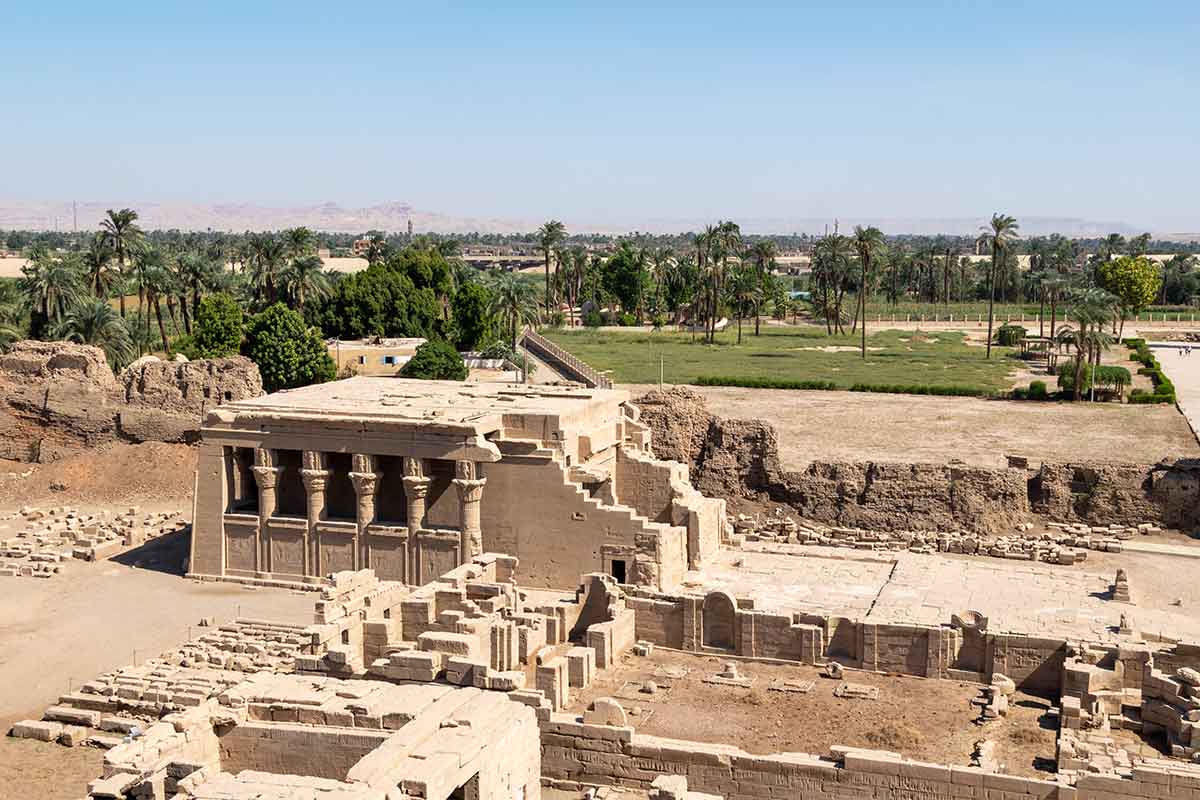
While the Temple of Dendera is the most renowned feature, Dendera was once an important city in ancient Egypt, serving as the capital of the sixth nome of Upper Egypt. Various sanctuaries dedicated to the goddess Hathor were located here, dating back to the Old Kingdom period over 2,000 years BC. Hathor was a beloved figure in Egyptian culture, revered as the protector of love and motherhood, as well as the mother of Horus – the celestial god in Egyptian religion.
The Temple of Dendera, along with the rest of the site visitors can see today, is considerably more recent. However, it’s important to note that it is still significantly older than many other monuments found in the West.
Construction of the temple began during the XXX Dynasty, under Nectanebo I, and was completed during the Greco-Roman period between 125 BC and 60 AD. Greek and Roman rulers, in an effort to secure their power and gain the support of the population, not only allowed but actively promoted Egyptian religious worship.
The temple of Dendera is one of the best examples of the Greco-Roman period in ancient Egypt, and its main promoters were probably Ptolemy XII and Cleopatra VII. In fact, there are references to this famous queen of the Ptolemaic dynasty, as well as to her son Caesarion, whose father was Julius Caesar. Tiberius, another promoter of the temple, also appears in an offering attitude in the interior decoration.
Despite some considering the temple to be an imitation of the style of ancient Egypt, the level of quality and perfection in the details make this of little importance. The Egyptians who enjoyed this site while it was in use celebrated multitudinous rites, such as the river procession starring the statue of the goddess Hathor in her boat to meet her son and later partner of Horus, in his temple of Edfu downstream. Festivities for this procession could last for days.
In addition to this river procession, the temple of Dendera was the end of the pilgrimage of many faithful, especially women who invoked Hathor for her maternal powers, and the sick, as they believed she also had healing powers.
The temple of Dendera faced damage from Coptic Christian believers who were against the goddess Hathor, damaging her sculpted face on the column capitals. Despite these episodes, the temple of Dendera was buried in mud from the Nile floods and desert sand, preventing dismantling and favoring its excellent state of preservation.
It remained buried until the arrival of Napoleon’s troops and successive explorer-treasure hunters in the late eighteenth and early nineteenth centuries, who did not hesitate to take important pieces of the temple. Especially its famous zodiac, now on display at the Louvre Museum, an element not without mystery that has contributed to the fame of this monument.
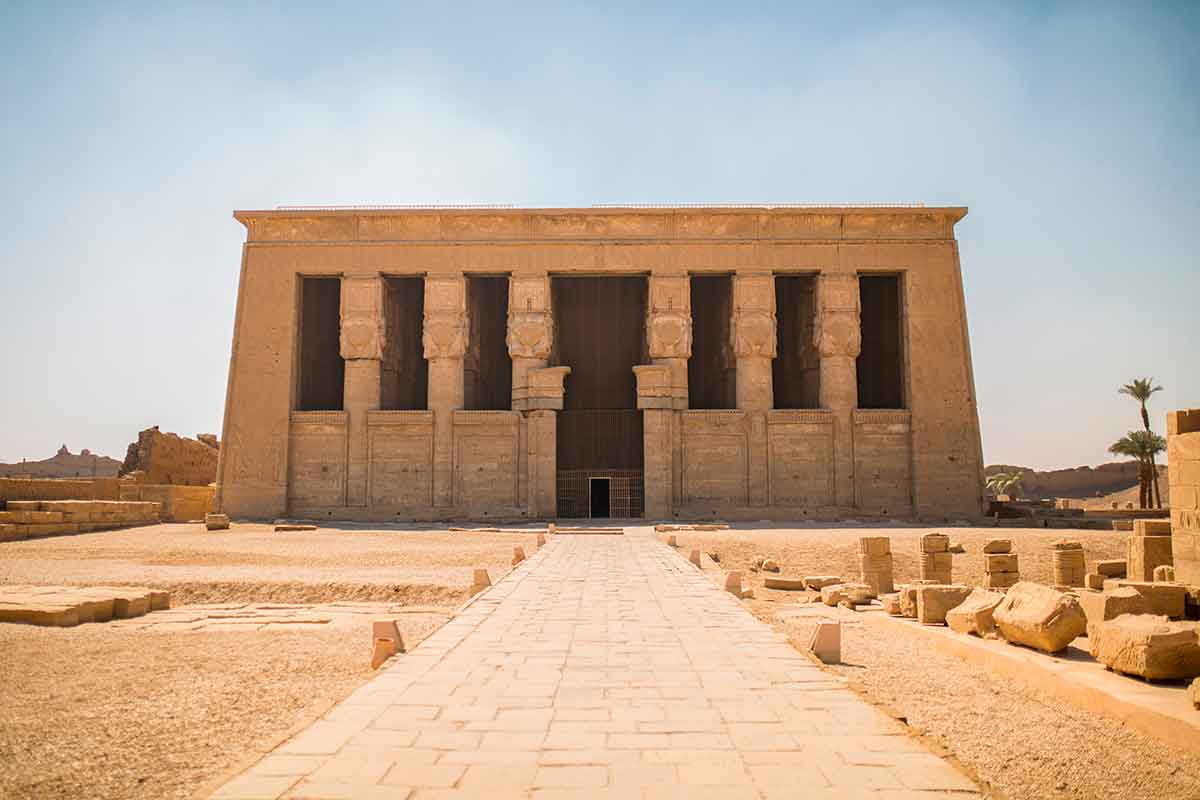
The religious compound of Dendera is an impressive open-air museum that offers visitors a unique glimpse into the past. Its excellent state of preservation allows visitors to appreciate the original colorful decorations that cover the ceilings, columns, walls, and other elements throughout the site, making it a must-see for those interested in Ancient Egypt.
While exploring the compound, there are several notable structures to visit. The most important is the Temple of Dendera, which is the main attraction. Additionally, visitors can explore the Iseum, and the Roman-era mammisi. We will review them below.
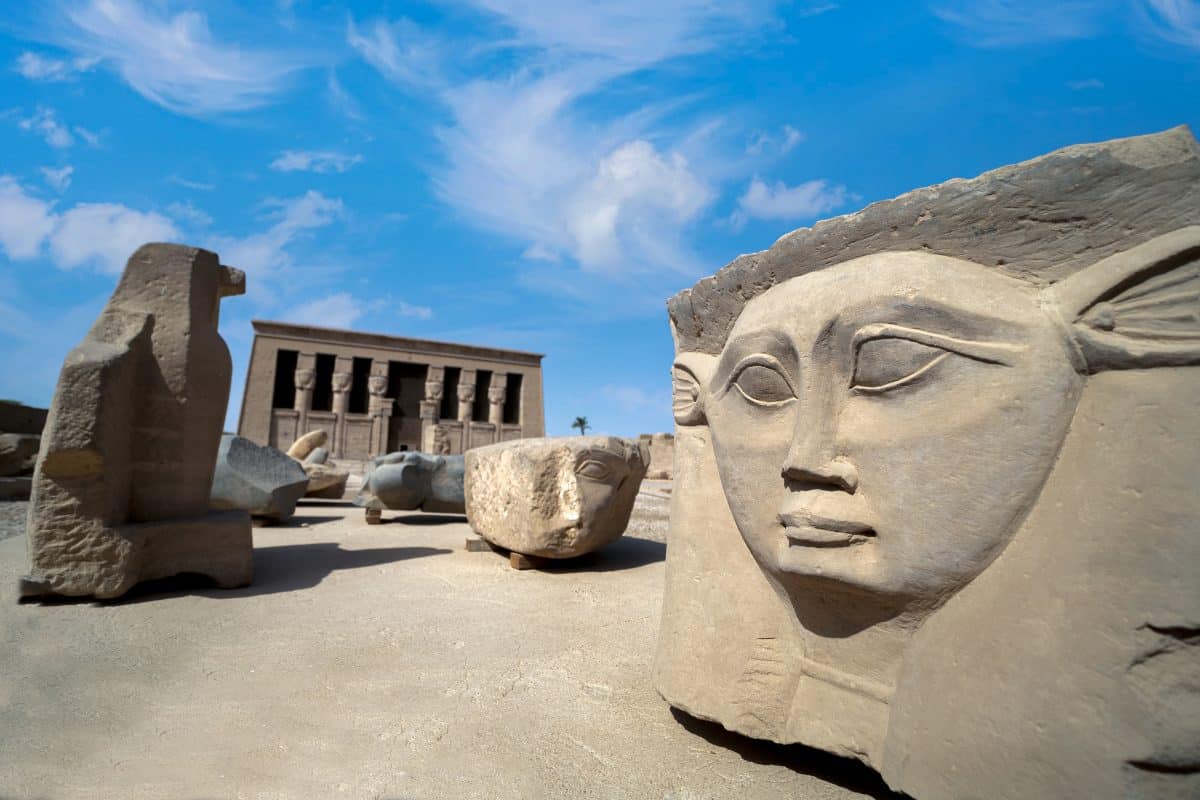
The Temple of Dendera, also known as the Hathor Temple, is the main attraction of the religious compound and a must-visit site. As visitors enter directly into the hypostyle hall, the grandeur of the temple is immediately evident. Although the entrance pylons are not preserved, the hall features 24 columns that are approximately 15 meters tall, each with Hathoric capitals depicting the face of the goddess Hathor with cow ears sculpted on all four sides.
While the Temple of Dendera has a simple plan, it has several other remarkable spaces that visitors can explore. The Hall of Appearances, for example, is where the statue of Hathor would make her appearance during religious celebrations. The sanctuary, which was accessible only to high priests and the pharaoh, housed the statue of Hathor and her ceremonial boat used in the fluvial procession towards Edfu.
In addition to the spaces dedicated to Hathor, the Temple of Dendera also has several sanctuaries for other gods such as Ra, Horus, and Sokar, as well as numerous halls, courtyards, and corridors.
Visitors can access the roof of the Temple of Dendera via a staircase that leads to two chapels. One of these chapels houses the famous Dendera Zodiac, which was removed from its original location by a French expedition at the beginning of the 20th century.
The temple was surrounded by a wall, which is now in a ruinous state. However, it still gives visitors an idea of the wall’s height and the total extent of the complex. The wall had monumental gates, with the preserved ones belonging to Roman emperors Domitian and Trajan, who oversaw their construction during their reigns.
The Iseum is a temple dedicated to the birth of Isis, another significant goddess in Egyptian mythology who had already assimilated attributes of Hathor during the heyday of the Temple of Dendera. However, this structure is poorly preserved today and offers less to see compared to the other temples within the compound.
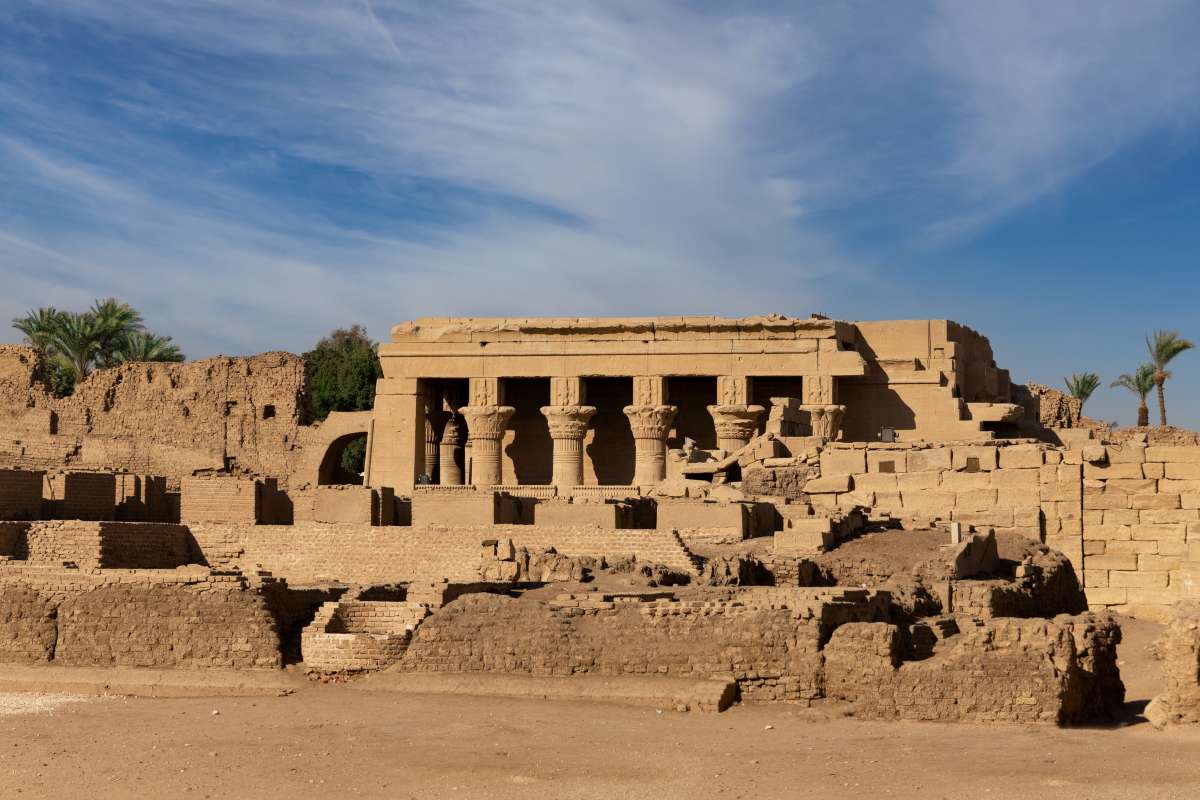
Mammisi were houses of divine birth, which aimed to glorify trilogies of gods – father, mother, and son – and were also seen as a way to assert the pharaoh’s power. This typology emerged during the Late Period, and Dendera boasts the oldest mammisi, that of Nectanebo I.
During the Greco-Roman period, mammisi became popular, and at Dendera, visitors can also appreciate the Roman mammisi, a small temple dedicated to Harsomtus (son of Hathor and Horus) built in the 1st or 2nd century AD, although it is unclear if it was constructed during the reigns of Augustus, Nero, or Trajan.
Lastly, near the Roman mammisi, visitors can identify the remains of a Christian basilica from the 5th century. It serves as an excellent example of early Coptic churches.
The Temple of Dendera is renowned for its fascinating and enigmatic elements, shrouded in mystery and intrigue. One of the most significant aspects of the temple is its relationship with astronomy, which demonstrates the profound knowledge of this discipline during ancient times.
The location of the temple was not accidental; its main axis, along with its corresponding gate, was intentionally oriented towards the north, specifically towards the star Thuban, which indicated the cardinal point during that era. The second main gate, on the other hand, was oriented towards the star Sirius, which was identified with the goddess Isis, closely associated with the goddess Hathor.
Sirius appeared only during the summer solstice, which coincided with the Nile’s annual rise, eagerly awaited by the Egyptian population. The period of the year when Sirius was hidden in the sky was interpreted as the journey of Isis and her husband Osiris through the underworld (Duat).
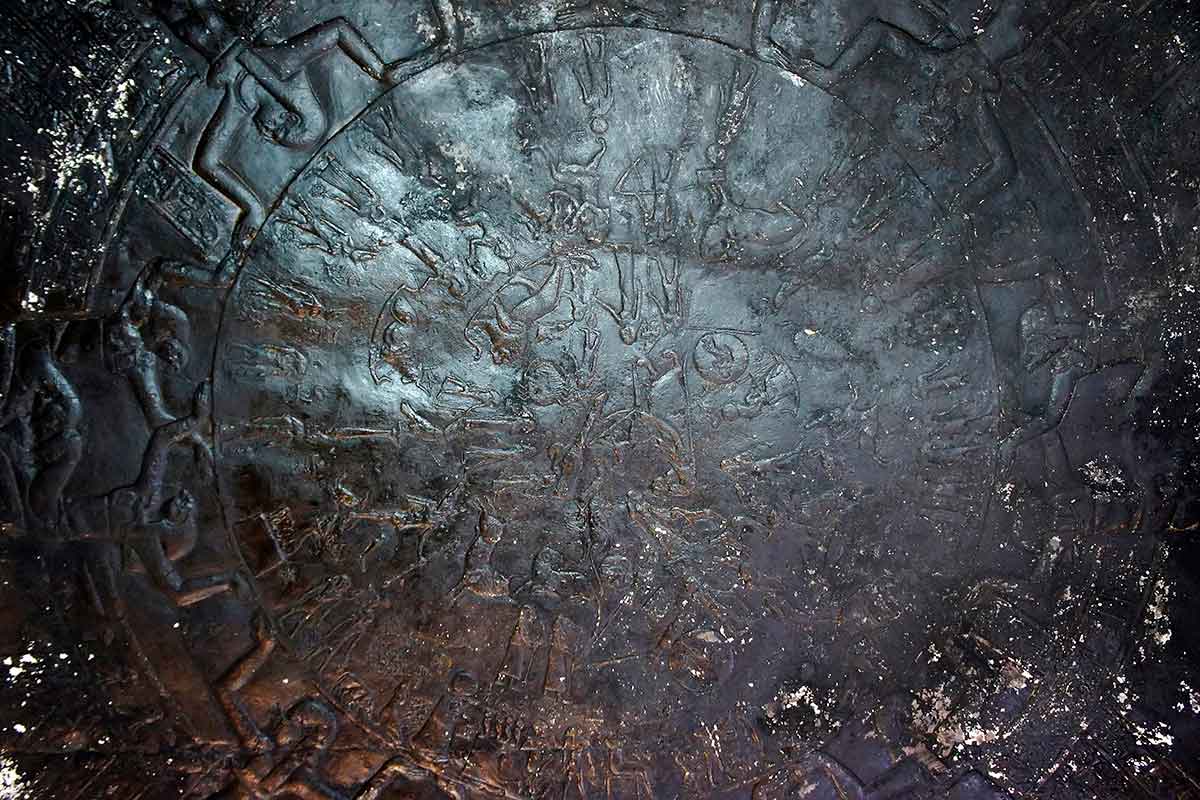
The Temple of Dendera is renowned not only for its careful astronomical orientation but also for the Dendera Zodiac, a bas-relief found on the ceiling of one of its chambers. Although the original is displayed at the Louvre Museum in Paris, a replica is installed here, allowing visitors to appreciate its significance.
The Dendera Zodiac is a circular star map, a groundbreaking creation during its time. The celestial vault is supported by four female-shaped pillars, and inside the circle, the 12 zodiacal constellations are illustrated. Some are depicted in the standard manner, while others are associated with local deities in the Egyptian style.
What has piqued the interest of scholars since its discovery is that it depicts two eclipses: a lunar eclipse that occurred in 52 BC and a solar eclipse in 51 BC, utilizing Ancient Egyptian symbolism. This discovery has assisted in refining the phases of the construction of the Temple of Dendera.
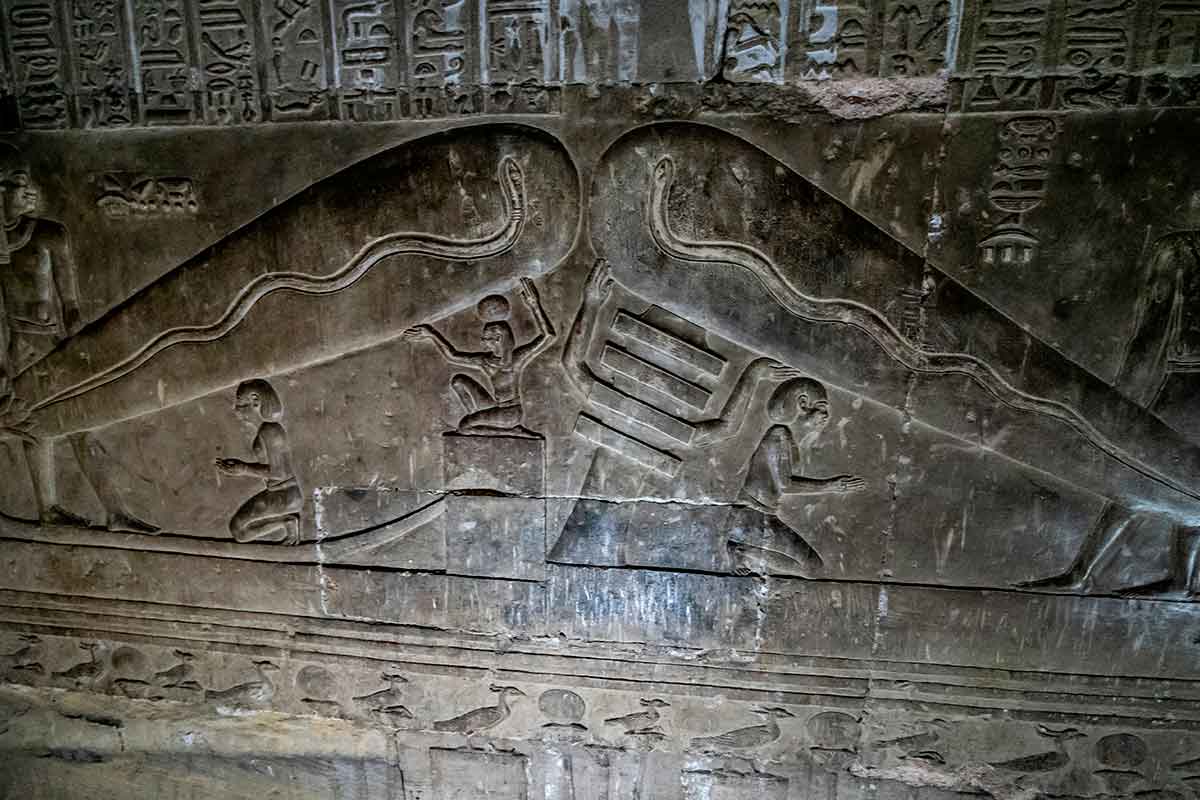
The Temple of Dendera has also been associated with the theory of the so-called “Dendera Lamps,” a controversial topic that has sparked debates and generated much curiosity. While it is certain that the ancient Egyptians were skilled in using various lighting techniques, including natural light and oil lamps, the notion of ancient electric light bulbs is still a matter of debate and skepticism.
However, reliefs from the temple of Dendera have given rise to a theory where fantasy and mystery want to mix with science. In them, some see the representation of primitive light bulbs, which would explain, from that point of view, that the ancient Egyptians knew electricity.
Egyptologists, on the other hand, refute this sui generis theory indicating that it is a representation of lotus flowers from which snakes representing Sema-tauy emerge, a unifying symbol of Upper and Lower Egypt, all supported by Dyed pillars, which in turn symbolize the stability of the kingdom.
The Temple of Dendera is situated on the outskirts of Qena, about 60 km north of Luxor. The easiest and most popular way to get to this city is by taking a tour from Luxor, which has its own international airport.
You can also include the temple of Dendera as a stop on a Nile cruise from Cairo or other points in Middle Egypt. However, the train and bus are not direct solutions for getting to this place, as they do not have stops for it.
The most comfortable and feasible option is to hire a private vehicle with a driver. This brings the temple of Dendera closer to many tourists in Egypt, both those who choose Luxor as their main destination and those who opt for a holiday in the Red Sea. For instance, a road trip from Safaga takes about two hours (160 km), from Hurghada two and a half hours (220 km), and from Marsa Alam four hours (360 km). It is also possible to combine a visit to the nearby temple of Abydos, which is about 90 km away.
We recommend relying on an expert agency like Egipto Exclusivo, where we can design a tailor-made trip that includes private transportation, accommodation, official guides to visit the temple of Dendera, and other main services. Contact us to enjoy a unique experience!


Fill out the form below to receive a free, no-obligation, tailor-made quote from an agency specialized in Egypt.
Travel agency and DMC specializing in private and tailor-made trips to Egypt.
Mandala Tours, S.L, NIF: B51037471
License: C.I.AN-187782-3